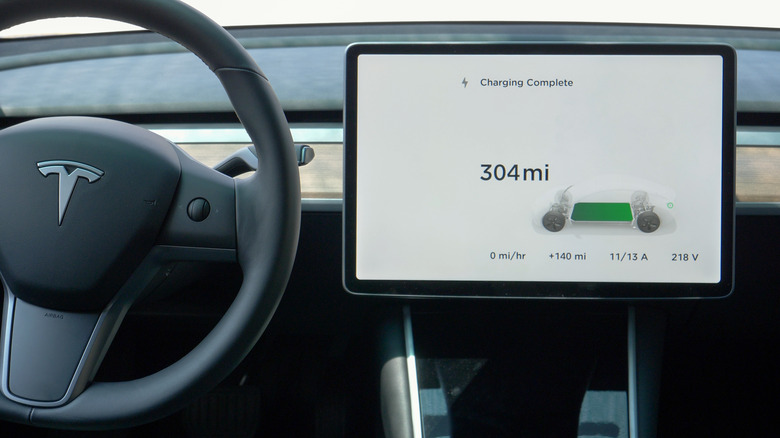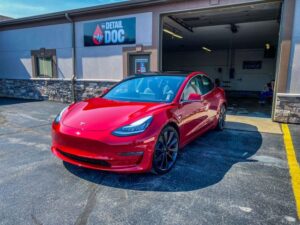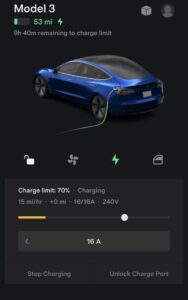Charging a Tesla to 100% is not always bad. But, it’s not ideal for daily use.
Tesla owners often wonder about battery health and optimal charging. Electric vehicles, especially Teslas, offer unique charging habits compared to traditional cars. Charging habits directly impact battery life and efficiency. Understanding how to maintain your Tesla’s battery can save you money and extend its life.
Many Tesla drivers aim for balance between range and battery health. This balance involves knowing when to charge fully and when to stop. By exploring battery care tips, you can keep your Tesla running smoothly. Learn why charging to 100% might not be best every day. Discover how to maximize battery health and enjoy your Tesla for years to come.

Credit: m.youtube.com
Tesla Battery Basics
Understanding Tesla’s battery technology is crucial for owners and enthusiasts alike. Tesla vehicles come equipped with advanced battery systems designed for longevity and efficiency. These batteries are central to the car’s performance and sustainability. Knowing the basics helps optimize usage and maintain the battery’s health over time.
Lithium-ion Composition
Tesla batteries use lithium-ion technology. This composition offers high energy density and efficiency. Lithium-ion cells are lightweight and rechargeable. They provide the necessary power for Tesla’s electric motors. The chemical makeup ensures fast charging and long-lasting performance. Proper charging habits maintain the integrity of these cells.
Battery Life Expectations
Tesla batteries are designed for durability. They typically last between 300,000 to 500,000 miles. Charging practices impact lifespan significantly. Regularly charging to 100% may reduce overall battery life. Tesla recommends charging to 80-90% for daily use. This habit preserves battery health and efficiency. Monitoring charging habits extends the battery’s functional lifespan.
Charging Myths
Charging a Tesla to 100% daily can degrade battery health over time. It’s best to limit full charges to occasional use. Frequent charging to 80% helps maintain optimal battery performance and longevity.
When it comes to electric vehicles, myths about charging are widespread. Many Tesla owners wonder if charging their vehicle to 100% is harmful. Let’s break down these charging myths and get to the truth.100% Charge Concerns
You’ve likely heard that charging your Tesla to 100% every day could be bad for the battery. Tesla’s battery management system is designed to prevent damage even if you charge to full capacity. However, Tesla recommends keeping the charge level between 20% and 80% for daily use to optimize battery health over time. Is it bad to charge to 100% occasionally? Not really. If you’re planning a long trip, a full charge is practical. Just avoid making it a daily habit. Frequent full charges can slightly degrade the battery’s long-term health.Fast Charging Impacts
Fast charging is another area full of myths. Some people believe it severely harms the battery. While it’s true that frequent fast charging can contribute to battery wear over time, the effect is minimal. Tesla’s Superchargers are designed to manage the heat and power flow to minimize impact. Are you worried about fast charging on a road trip? Don’t be. It’s efficient and convenient, especially when time is crucial. The key is balance. Use fast charging when necessary, but rely on slower home charging for regular use. Understanding these myths helps you make informed decisions. How do you charge your Tesla? Share your thoughts in the comments below!Optimal Charging Practices
Charging your Tesla effectively can extend its battery life. Understanding optimal practices helps maintain performance. It’s not just about plugging in. It’s about knowing the best charge levels and timing. These strategies ensure your vehicle stays efficient.
Ideal Charge Levels
Keeping your Tesla’s charge between 20% and 80% is ideal. This range minimizes battery wear. Charging to 100% regularly can stress the battery. Use 100% charge only for long trips. This practice helps prolong battery life.
Nighttime Charging Tips
Charging overnight has benefits. Electricity rates are often lower. Cooler temperatures reduce battery heat stress. Schedule charging to finish by morning. This helps balance energy use. Setting a fixed charging time can be helpful. It makes sure your car is ready for the day ahead.

Credit: www.reddit.com
Effects Of 100% Charging
Charging your Tesla to 100% might seem like a good idea. It ensures maximum range. But it can have effects on the battery and performance. Understanding these effects helps in making informed decisions.
Battery Health Implications
Constant full charging can strain the battery. Batteries perform best in the mid-range. Charging to 100% frequently can degrade them faster. It reduces the battery’s lifespan. This means you might need a replacement sooner.
Performance And Efficiency
Fully charged batteries may not offer optimal performance. High charge levels can lead to heat build-up. This affects efficiency during driving. The car might use more energy to maintain performance. Efficiency and range can decrease over time.
Manufacturer Recommendations
Understanding how to charge your Tesla is crucial. Following the manufacturer’s guidelines ensures your battery’s health. Tesla provides specific instructions for charging practices.
These guidelines help maintain battery efficiency. They also prolong the battery’s lifespan. Let’s explore Tesla’s charging recommendations further.
Tesla’s Charging Guidelines
Tesla advises avoiding frequent full charges. Regularly charging to 100% may stress the battery. Instead, Tesla suggests maintaining a charge between 20% and 90%.
This practice keeps the battery in optimal condition. For long trips, charging to 100% is okay. Just avoid doing it daily.
Warranty Considerations
Tesla’s warranty covers battery performance. Consistent full charging might affect warranty claims. Following Tesla’s recommendations supports warranty terms.
Proper charging habits can prevent potential issues. This ensures your vehicle remains under warranty protection.
Comparative Insights
Charging a Tesla to 100% can cause battery wear over time. Experts suggest keeping it between 20-80% for longevity. Occasional full charges are fine, but regular use may affect battery health.
Charging your Tesla to 100% might seem like a no-brainer when planning a long trip or ensuring you have a full battery. However, there’s more to consider. Understanding how Tesla’s charging practices compare to other electric vehicles (EVs) can help you make informed decisions. The experiences of Tesla users also offer valuable insights into whether charging to full capacity is beneficial or potentially harmful.Tesla Vs. Other Evs
Tesla has set the benchmark for electric vehicles, but how does its battery management system compare to other EVs? Many manufacturers recommend not charging to 100% regularly. Nissan Leaf, for example, suggests keeping it between 20-80% for optimal battery health. Tesla, however, has its own guidelines. While it’s fine to charge to full occasionally, doing so frequently might degrade the battery faster. Other EVs like the Chevy Bolt have similar recommendations, yet Tesla’s advanced battery technology often leads to debates. Is Tesla’s system truly superior, or do these general rules still apply?User Experiences
Tesla owners have shared varied experiences about charging habits. Some users routinely charge to 100% for daily commutes without noticeable issues. Others prefer keeping it at 80% for peace of mind, believing it extends battery life. One Tesla Model 3 owner mentioned charging fully only for long trips. They noticed minimal degradation over two years, suggesting moderate charging helps. These personal stories highlight a practical approach. Could your charging routine affect your Tesla’s performance in the long run? The debate continues, but your driving habits and needs can guide your decision. Be mindful of the trade-offs and the potential impact on your vehicle’s longevity. How do you prioritize convenience versus battery health?Technology Advancements
Technology advancements in electric vehicles have transformed the way we drive. Tesla, a leader in this field, continuously pushes boundaries. Understanding these advancements helps us better use and care for our vehicles. This includes knowing about charging practices and their impacts on battery health.
Battery Innovation
Tesla’s batteries have seen significant improvements over time. These innovations focus on enhancing energy density and lifespan. New materials and designs make batteries more efficient. With these changes, charging to 100% becomes less of a concern. The risk of degrading the battery reduces as technology advances.
Understanding these improvements helps owners make informed charging decisions. Staying updated on battery technology can optimize your vehicle’s performance. This knowledge ensures a longer-lasting and efficient battery life.
Future Charging Solutions
Tesla is exploring future charging solutions to simplify user experience. Fast-charging technology is becoming more accessible. It allows users to charge quickly without damaging the battery. The company also invests in wireless charging solutions. This can offer more convenience and safety for users.
These advancements aim to make charging more efficient and user-friendly. They also focus on integrating charging solutions into daily life seamlessly. Adopting these technologies can lead to better battery health and vehicle performance.
Environmental Impact
Charging a Tesla to 100% can impact the battery’s longevity and efficiency. Frequent full charges might lead to faster battery degradation over time. Keeping the charge between 20% and 80% is often recommended to maintain optimal performance and reduce environmental impact.
Charging your Tesla to 100% might seem like a logical choice if you want to maximize your driving range. However, it’s important to consider the environmental impact of this decision. While Tesla vehicles are known for being environmentally friendly, the way you charge them can affect their eco-friendliness. Let’s dive into the details.Energy Consumption
When you charge your Tesla to 100%, you’re not just using more energy; you’re also increasing demand on the power grid. This can lead to higher emissions, especially if the electricity comes from non-renewable sources. Have you thought about how your charging habits might contribute to this? Consider the energy-intensive process of storing electricity in lithium-ion batteries. It’s not just about plugging in; it’s about understanding the energy cycle. If more people opt for 100% charges, the cumulative energy usage can be significant.Sustainable Charging
Opt for sustainable charging practices to reduce your environmental footprint. Charging your Tesla to 80-90% is often sufficient for daily driving needs and can extend your battery’s lifespan. This approach can also help in reducing the strain on energy resources. Have you explored the benefits of using solar panels or other renewable energy sources for charging? By doing so, you can ensure your Tesla remains as green as possible. Consider setting up a charging schedule during off-peak hours to minimize grid impact. Think about the ripple effect your charging habits have on the environment. Small changes in how you charge can lead to a more sustainable future. Are you ready to make a positive impact? Embrace these insights and adopt a more eco-conscious approach. Your actions today can pave the way for a greener tomorrow.
Credit: www.slashgear.com
Frequently Asked Questions
Should You Charge Your Tesla To 100%?
Charging your Tesla to 100% occasionally is fine. Regularly charging to 80% prolongs battery lifespan. For long trips, full charge is ideal. Avoid frequent deep discharges to maintain battery health.
Is It Okay To Charge A Tesla To 100 For Long Trips?
Charging a Tesla to 100% for long trips is okay occasionally. Doing this ensures maximum range. However, regular charging to 80-90% is recommended for battery health. Always plan charging stops for longer journeys to optimize performance.
Is It Bad To Charge A Car To 100%?
Charging a car battery to 100% occasionally is okay, but frequent full charges can degrade battery lifespan. Aim for 80-90% for regular use. Modern EVs have systems to prevent overcharging, protecting battery health. Following manufacturer guidelines helps maintain optimal performance and longevity.
Should I Charge To 100% Tesla On Reddit?
Charging a Tesla to 100% occasionally is safe, but avoid it daily to maintain battery health. Regularly charge to 80-90% for optimal performance and longevity. Check Tesla’s guidelines for specific model recommendations. Keep software updated for best charging practices.
Conclusion
Charging your Tesla to 100% isn’t always necessary. Regularly hitting full charge can reduce battery life. Aim for 80-90% for daily use. It helps extend your battery’s lifespan. Sometimes, you might need full charge for long trips. It’s okay to charge fully when needed.
Just avoid making it a habit. Keeping your battery healthy ensures better performance. Consider your driving needs before charging to 100%. Smart charging choices lead to a longer-lasting battery. Protect your investment with mindful charging practices. Your Tesla will thank you in the long run.

